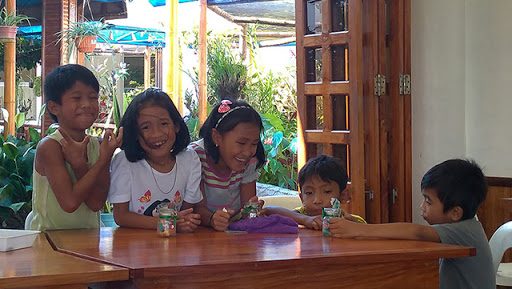SUMMARY
This is AI generated summarization, which may have errors. For context, always refer to the full article.

ALBAY, Philippines – Moving at the pace of one letter at a time, 65 school graders from impoverished families in Albay have benefited from a summer reading program, which is now on its seventh year.
The 20-day reading enhancement program, which ran from April 22 to May 17 at Mirisbiris Garden & Nature Center in Sto Domingo town in this province, aims to help the students struggling to read by teaching them the sound of the letters.
“If they can connect the sound to the letter, which by the way is simply a symbol, they can read any word,” said reading volunteers trainer Humilidad Perfecto.
Humilidad or “Manay Yumi” to volunteers was a retired reading teacher and a scholar at the University of the Philippines when she was a young teacher.
Manay Yumi’s expertise was sought by her sister Glenda Newhall, who has been organizing this project with her husband Chris.
Method
The method they use is the Marungko Approach, which teaches a child to sound the letter they are seeing.
Hence, they begin with letter sounds than names. In other words, phonetic teaching.
According to Manay Yumi, this approach is used for first languages such as Bicol and Filipino. One because it fits the nature of our language, which is very phonetic thus this rule: Kung ano ang bigkas, siyang baybay (How you say it is how you spell it.) It is the easiest approach too, she said.
“We start with the consonant letters M and S and add letter A, the easiest of the vowel letters, said Manay Yumi.
With these they can already read simple words like mama (mother), masa (masses), and sama, to name a few, she said.
However, they are careful not to introduce all the letters at once because for her that is the way to producing non-readers.
What they do is a pre-assessment to know where to begin and how to personalize the approach.
The volunteers

This year there are 35 volunteers for this program. They are a mixture of return and first-time volunteers, youth leaders and scholars of the Newhall couple.
One of them is Minerva who is now a Special Education (SPED) teacher. Her most important takeaway from this experience is that children got the courage to read when they see someone is willing to help them and believes they can.
These she observed from the development in Bernard, her relative who joined the program this year.
According to her, Bernard is a Grade 9 bullied boy because he couldn’t read.
His mother registered him for this program and now he’s into book reading.
Some volunteers like Kim Jacob and Lea Balderama didn’t know they would like teaching until they volunteered.
For Jomar Bellen, who is a five-time volunteer, he finds it overwhelming because he feels that the children’s success is also theirs.
Jasper Banzuela is likewise happy in volunteering especially that the kids are appreciative.
“They would hug us and call us when they see us,” he said.
Saniel Celso and Cyril Baile are both working and returned this year after years of hiatus.
According to Saniel who is supporting himself, he knows how poverty can hinder learning because he had experienced it.
That’s why he would give the kids a reward (snack food) after a reading activity, in addition to the snack provided by the Newhall couple.
Erma, the first-timer, handled Bernard and gained friends.
Supplement, not alternative
Chris Newhall said that their program is a supplement, not an alternative, to formal schools reading programs.
He also said that it does not take a lot of money to organize one, and he sees potential in other barangays in their town.
As long as there are youth willing to volunteer, it can be replicated, he said.
Glenda Newhall also mentioned that they need volunteers for more advanced aspects of reading such as identifying the main topic, summarizing, and comprehension – all parts of their ambitious plan when they were starting out.
But when they received the first batches of children and the succeeding ones from their barangay in Salvacion in this town, they knew they had to refocus.
“There are a lot of factors that hinder a child from learning how to read, like nutrition, clinical conditions, behavior, and mindset,” said Glenda.
She added that “some wouldn’t show up because they already felt defeated – sadly. But we hold on to those who stay because of their enthusiasm.”
She believes once these children get over the hump, learning follows. – Rappler.com
Add a comment
How does this make you feel?
There are no comments yet. Add your comment to start the conversation.